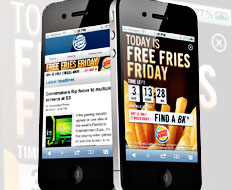Quick-service operators increasingly have the ability to target their customers right where they are. The industry’s use of mobile marketing has grown exponentially over the last two years, and marketers are projected to spend $1.2 billion on mobile display advertising (not including smartphone apps, mobile coupons, and other mobile ads) by 2014, according to eMarketer.
Several major quick-serve chains have rolled out apps allowing customers to create and submit their order virtually using their mobile devices and computers. Other operators are using geo-location mobile marketing—which uses GPS technology to locate smartphone users—and audience targeting to reach potential customers who live, play, or work near their stores.
“You can never make it too easy to buy from you and, in [quick service], it is more important than anywhere else in the restaurant industry,” says Aaron D. Allen, owner of global restaurant consulting firm Aaron Allen & Associates.
For example, Domino’s Pizza Tracker smartphone app lets customers see where their pizza is in the preparation process and who is making it. And Domino’s Pizza Hero app, launched in Europe last fall, features a game that lets users make pizzas and time themselves against friends or other players. The virtual pizza is then turned into an order.
“The pizza chains—Domino’s, Pizza Hut, Papa John’s, and others—are way out in front [with mobile marketing], which makes sense because around 30 percent of pizza sales originate online,” Allen says.
Last spring, Subway launched an app that allows users to locate the nearest Subway that takes smartphone offers, build their sandwich or salad, share their choices for group orders, and save their favorite orders. Another Subway app lets users build a sandwich along a virtual production line styled after Subway’s in-store counters. Customers choose a pick-up time and pay for their order with their mobile devices. Similarly, Jamba Juice recently released a smartphone app that allows customers to order, pay through PayPal, and designate a pick-up time.
Some innovative geo-location-based mobile campaigns are being tested at U.K. quick serves. In April, KFC began testing its KFC Fast Track app in 10 U.K. stores, according to restaurant consulting firm Technomic. The app uses geo-location technology to pinpoint the nearest KFC stores; users can then create an order and pay remotely via credit card. A QR code and confirmation number are provided to users to speed up in-store pickup. When customers arrive at their selected KFC store, they check out in a dedicated Fast Track checkout line, and a mobile check-in lets staff members know they are present.
“Consumers appreciate tools that will make the ordering and payment process easier,” says Mary Chapman, director of product innovation for foodservice consulting firm Technomic. She adds, however, that if an app adds steps to the process or pesters consumers to the point that it is viewed as spam, it won’t be effective. “Consumers are bombarded with messages on their phones, so it’s not easy to stand out.”
A host of marketing providers, including 5th Finger, 12snap, Amobee, and gomeeki, have sprouted up to provide business like quick-service restaurants with mobile capabilities. When Burger King chose to use geo-location mobile advertising for its new french fries launch in 2011, it worked with location-based mobile advertising firm Verve Mobile. Verve helped Burger King on a mobile ad campaign that featured a tap-to-calendar feature in which mobile users could add an event to their calendar to remind them when they could visit their local Burger King restaurant to get a free sample of the new french fries.
“The Burger King Free Fries Friday campaign is also a prime example of leveraging dynamic location data into the mobile ad creative, because it shows the user exactly how far they are from their nearest Burger King restaurant location, ” says Tom MacIsaac, CEO of Verve Mobile.
MacIsaac says Verve worked with another national quick-serve chain to promote its discount menu. Verve used a “geo-aware” mobile marketing campaign, which targeted smartphone users within a desired market, such as a city or DMA, with banner ads on their mobile devices. The chain promoted certain items on its discount menu with ads that expanded to include an interactive menu gallery and a map to the nearest restaurant.
The click-through rate on the chain’s banner ad was 3.21 percent, MacIsaac says, compared with the average 0.33 percent for most mobile marketing campaigns. Consumers also spent an average of 23 seconds with the expandable ad.
Despite some quick-service brands’ successful use of mobile marketing, many operators are still missing the boat, consultants say. “There are so many creative ways to do it, but it is surprising how many still view this as techno babble and something that is for the kids,” Allen says. “There are more people on planet Earth with a mobile phone than a toothbrush.”
“So far, it’s mostly the larger chains like McDonald’s and Burger King,” MacIsaac adds, “but we expect that the entire industry will embrace it over the near term.”
The cost of building a smartphone app is nothing compared with the return that restaurant operators can get from targeting customers where they are, Allen says.
“Thirty to 40 percent of your consumers will go to your website first, and a growing part of online ordering is mobile,” he says. “You should have as much investment and thought put into your mobile strategy as you do with creating a new restaurant site.”




